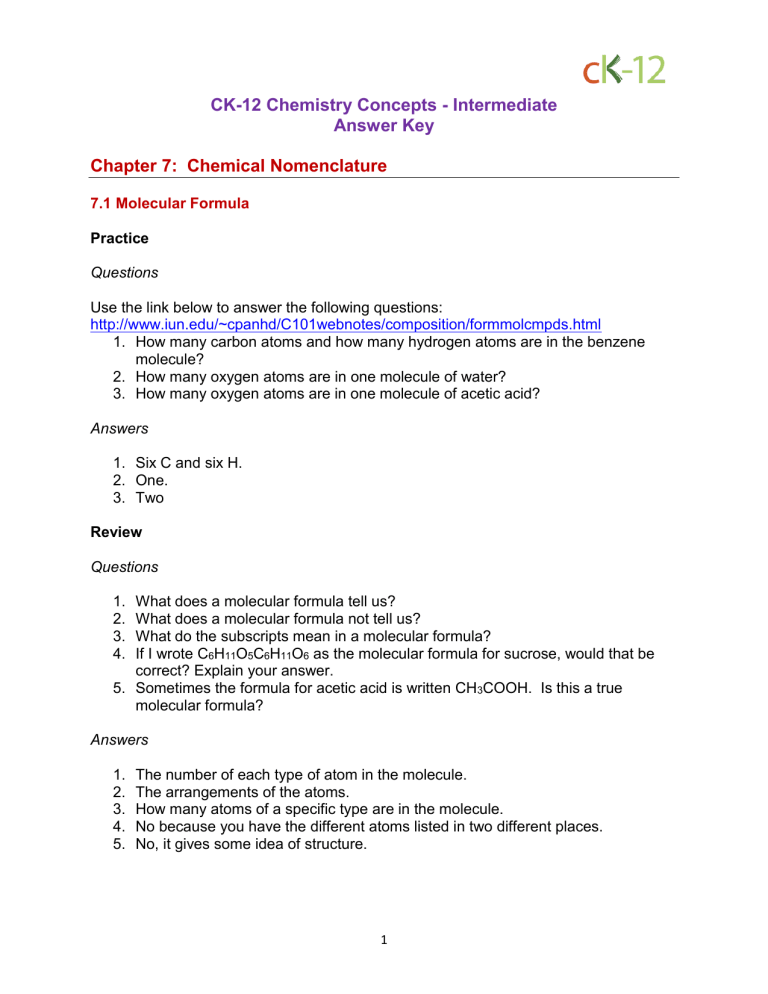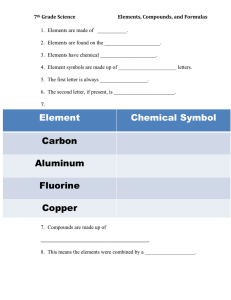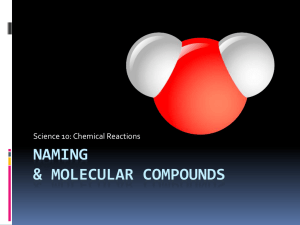
CK-12 Chemistry Concepts - Intermediate Answer Key Chapter 7: Chemical Nomenclature 7.1 Molecular Formula Practice Questions Use the link below to answer the following questions: http://www.iun.edu/~cpanhd/C101webnotes/composition/formmolcmpds.html 1. How many carbon atoms and how many hydrogen atoms are in the benzene molecule? 2. How many oxygen atoms are in one molecule of water? 3. How many oxygen atoms are in one molecule of acetic acid? Answers 1. Six C and six H. 2. One. 3. Two Review Questions 1. 2. 3. 4. What does a molecular formula tell us? What does a molecular formula not tell us? What do the subscripts mean in a molecular formula? If I wrote C6H11O5C6H11O6 as the molecular formula for sucrose, would that be correct? Explain your answer. 5. Sometimes the formula for acetic acid is written CH3COOH. Is this a true molecular formula? Answers 1. 2. 3. 4. 5. The number of each type of atom in the molecule. The arrangements of the atoms. How many atoms of a specific type are in the molecule. No because you have the different atoms listed in two different places. No, it gives some idea of structure. 1 7.2 Empirical Formula Practice Questions Use the link below to answer the following questions: http://pages.towson.edu/ladon/empiric.html 1. How is an empirical formula calculated? 2. How is the number of moles determined from the percent composition? Answers 1. To calculate the empirical formula: a. determine the weight percent of each element b. calculate the number of moles of each element c. determine the ratio of moles for each element. 2. To calculate moles: a. find the percentage of each element b. assume a weight of 100 grams for the compound c. the percent of each element is then the number of grams in 100 g of compound d. divide grams by atomic weight of element to get number of moles. Review Questions 1. Define “empirical formula”. 2. Why is C6H12O6 not considered to be an empirical formula for glucose? 3. Can the empirical formula for a compound be the same as the molecular formula? 4. What do we need to know in order to determine a molecular formula from an empirical formula? 5. Give three examples of compounds whose empirical formulas are the same as their molecular formulas. Answers 1. A formula that shows the elements in a compound in their lowest whole-number ratio. 2. It does not show the smallest whole number ratio of elements. 3. Yes. 4. The actual molecular weight. 5. H2O, NH3, HCl. 2 7.3 Cations Practice Questions Use the link below to answer the following questions: http://dl.clackamas.edu/ch104-07/cations.htm 1. How many electrons are there in the outer shell of Group IA elements? 2. What is the charge of Group IA ions? 3. How many electrons are there in the outer shell of Group IIA elements? 4. What is the charge of Group IIA ions? Answers 1. 2. 3. 4. One plus 1 Two plus 2 Review Questions 1. 2. 3. 4. 5. What is an ion? What is the cathode? Write the symbol for the barium cation. Write the symbol for the cesium cation. List three ways cations are useful. Answers 1. 2. 3. 4. 5. A non-elemental form of an atom The negative pole of an electrical field. Ba2+ or Ba++. Cs+ or Cs1+ Blood pressure regulation, muscle contraction, bone structure. 7.4 Anions Practice Questions 3 Use the link below to answer the following questions: http://preparatorychemistry.com/bishop_anion_names_formulas_help.htm 1. Why do elements form anions? 2. Why do group 17 elements form anions more readily than group 1 elements? Answers 1. To get the same number of electrons as the nearest noble gas. 2. Nonmetallic elements attract electrons better than metallic elements. Review Questions 1. 2. 3. 4. 5. 6. What is an anion? How are anions formed? Why do anions form? How are anions named? List three examples of anions with names, charges, and chemical symbols. List three ways anions are used. Answers 1. 2. 3. 4. 5. 6. Negative ion formed when a nonmetal gains one or more electrons. Electrons are added. So the element will have the electron configuration of a noble gas. Drop the end of the element name and replace with –ide oxide O2-, chloride Cl-, bromide BrFluoride ion is widely used in water supplies to help prevent tooth decay. Chloride is an important component in ion balance in blood. Iodide ion is needed by the thyroid gland to make the hormone thyroxine. 7.5 Transition Metal Ions Practice Questions Use the links below to answer the following questions: http://chemed.chem.purdue.edu/genchem/topicreview/bp/ch12/trans.php 1. List some similarities between transition metals and main-group metals. 2. List some differences between transition metals and main-group metals. 3. Describe the electron configurations of the cobalt ions. Answers 4 1. Form positive ions, malleable, ductile, good conductors of heat and electricity. 2. Transition metals more electronegative and more likely to form covalent bonds. 3. element Co: [Ar] 4s2 3d7, ions Co2+: [Ar] 3d7, Co3+: [Ar] 3d6. Review Questions 1. What is unique about the electron configurations of transition metals? 2. Which electrons of transition metal elements are most likely to be lost duing ion formation? 3. How many ions can iron form? 4. Which transition metal forms only one ion? 5. List several uses for transition metals. Answers 1. 2. 3. 4. 5. Unfilled inner d shells. s electrons two silver electronics, monetary systems, chemical catalysts 7.6 Naming Binary Ionic Compounds Practice Questions Use the link below to answer the following questions: http://library.thinkquest.org/19957/nomen/binarybody.html 1. What is the stem for compounds using the oxygen anion. 2. How would you name AlN? 3. How would you name NaCl? Answers 1. ox 2. aluminum nitride 3. sodium chloride Review Questions 5 1. What is a binary compound? 2. Which of the following is not a binary compound? a. NaCl b. KH2PO4 c. KBr 3. Name the following compounds: a. NaBr b. MgCl2 c. LiI d. CaO e. CuBr2 f. FeO Answers 1. composed of one monatomic cation and one monatomic anion. 2. compound b 3. Names a. sodium bromide b. magnesium chloride c. lithium iodide d. calcium oxide e. cupric bromide f. ferrous oxide 7.7 Stock System Naming Practice Questions Practice naming compounds at this web site: http://www.chemteam.info/Nomenclature/Binary-Stock-FormulatoName.html Answers Answers on web site. Review Questions 1. What is the Stock system? 2. For which group of metal ions would we use the Stock system? 6 3. What does the Roman numeral stand for? 4. Assign a Roman numeral to each of the following cations: a. Sn4+ b. Fe3+ c. Co2+ d. Pb4+ Answers 1. 2. 3. 4. A system for naming compounds of transition metals Transition metals The charge on the cation Numbers: a. IV b. III c. II d. IV 7.8 Formulas for Binary Ionic Compounds Practice Questions Use the link below to answer the following questions: http://www.chemteam.info/Nomenclature/Binary-Comm-NametoFormula.html 1. How did Lavoisier improve chemical nomenclature? 2. Practice writing formulas using some of the examples given here. Answers 1. He published a book on nomenclature and developed rules based on differences in composition. 2. Answers are given on the web site. Review Questions 1. Write formulas for the binary ionic compounds formed between the following pairs of elements: a. cesium and fluorine c. aluminum and chlorine b. calcium and sulfur d. zinc and nitrogen 2. Write the formula and give the name for the compound formed by the following ions: a. Fe3+ and O2− c. Au+ and Cl− 7 b. Ni2+ and S2− 3. Give names for the following compounds: a. Ag2S b. PdO d. Sn4+ and I− c. PtCl4 d. V2O5 Answers 1. a. CsF, b. CaS c. AlCl3 d. Zn3N2 2. a. Fe2O3 ferric oxide or iron (III) oxide, b. NiS nickel (II) sulfide, c. AuCl gold chloride, d. SnI4 tin(IV) iodide 3. a. silver sulfide b. palladium (II) oxide c. platinum (IV) chloride d. vanadium (II) pentoxide. 7.9 Polyatomic Ions Practice Questions Use the link below to answer the following questions: http://www2.pvc.maricopa.edu/tutor/chem/chem130/nomenclature/polyatomicion.html 1. List the polyatomic cations. 2. How many polyatomic ions of chromium are there? Write out the formulas and name each ion. 3. How many polyatomic ions of chlorine are there? Write out the formulas and name each ion. Answers Check the web site to make sure you have included all the needed information. Review Questions 1. Write the formulas for the following ions: a. ammonium b. carbonate c. sulfate d. phosphate? 2. Name the following ions: a. PO33b. SiO32c. OH- 8 d. MnO4Answers 1. a. NH4+, b. CO32-, c. SO42-, d. PO432. a. phsophite b. silicate c. hydroxide d. permanganate 7.10 Names and Formulas of Ternary Ionic Compounds Practice Questions Use the link below to answer the following questions: http://www.youtube.com/watch?v=QNijl4ZBJCw 1. What are ionic compounds containing polyatomic ions called? 2. Does the “criss-cross” method work for naming ternary compounds? Answers 1. Ternary compounds 2. Yes Review Questions 1. What is a ternary compound? 2. What is the basic rule for naming ternary compounds? 3. Write the formulas for the following compounds: a. mercury (II) nitrate b. ammonium phosphate c. calcium silicate d. lead (II) chromate 4. Name the following compounds: a. KClO3 o Rb2SO4 o Cd(NO3)2 o NaCN Answers 1. A compound with three or more elements. 2. Same rule as naming binary ionic compounds. 3. a. Hg(NO3)2 b. (NH4)3PO4 c. CaSiO3 d. PbCrO4 9 4. a. potassium chlorate b. rubidium sulfate c. cadmium nitrate d. sodium cyanide 7.11 Naming Binary Molecular Compounds Practice Questions Use the link below to answer the following questions: http://www.iun.edu/~cpanhd/C101webnotes/chemical-nomenclature/bimolcmpds.html 1. What order is used to write the elements of a molecular compound? 2. How many elements are in a binary molecular compound? 3. What is the advantage of using a systematic name over a generic name? Answers 1. In order of increasing group number. 2. Two. 3. The formula of the compound can be deduced from the name. Review Questions 1. 2. 3. 4. 5. What are molecular compounds? How do they differ from ionic compounds? What holds the atoms of a molecule together? Are the elements of molecular compounds metals or non-metals? List the prefixes for the number of atoms of an element when there are four atoms of that element in the compound. 6. List the prefixes for the number of atoms of an element when there are seven atoms of that element in the compound. 7. Name the following compounds: a. ClF3 b. As2O5 c. B4H10 Answers 1. 2. 3. 4. 5. Inorganic compounds that take the form of discrete molecules. The atoms share electrons. Bonds form between the atoms. Nonmetals. Tetra- 10 6. Hepta7. a. chlorine trifluoride b. diarsenic pentoxide c. tetraboron decahydride 7.12 Naming Acids Practice Questions Use the link below to answer the following questions: http://www.kentchemistry.com/links/naming/acids.htm : 1. When naming acids, is the hydrogen named? 2. What prefix is added to the anion root? 3. What suffix is added to the anion root? 4. How are oxo acids named? Answers 1. 2. 3. 4. No. hydro–ic The acid name comes from the root name of the oxyanion name or the central element of the oxyanion. Review Questions Define “acid”. What is a binary acid? What is an oxoacid? Name the following acids: a. H2SO4 b. HCN c. HCl d. H3PO4 5. Write formulas for the following acids: a. hydrobromic acid b. perchloric acid c. nitrous acid 1. 2. 3. 4. Answers 1. A molecular compound that contains one or more hydrogen atoms and produces hydrogen ions (H+) when dissolved in water. 11 2. 3. 4. 5. Contains H and a monatomic anion. Contains H, O, and one other element. a. sulfuric acid b. hydrocyanic acid c. hydrochloric acid a. HBr b. HClO4 c. HNO2 d. phosphoric acid 7.13 Names and Formulas of Bases Practice Questions Use the link below to practice naming bases and writing formulas for bases: http://www.chem.uiuc.edu/webfunchem/bases/nombaseIndex.htm Answers Answers will be seen on the web site Review Questions 1. What is a base? 2. What is the charge on the hydroxide anion? 3. Name the following bases: a. LiOH b. Mg(OH)2 c. Fe(OH)3 4. Write the formulas for the following bases: a. nickel (II) hydroxide b. aluminum hydroxide c. silver hydroxide Answers 1. 2. 3. 4. A compound that produces hydroxide ions when dissolved in water. OHa. lithium hydroxide b. magnesium hydroxide c. iron (III) hydroxide a. Ni(OH)2 b. Al(OH)3 c. AgOH 12





